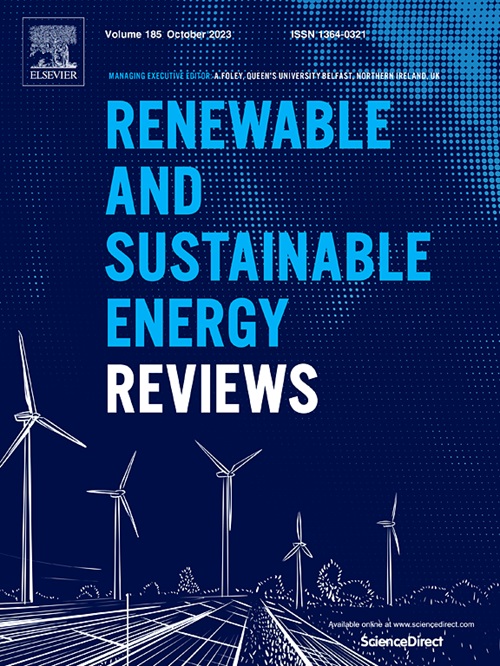ZnO纳米材料的带隙工程以提高电化学和光催化效率
IF 16.3
1区 工程技术
Q1 ENERGY & FUELS
引用次数: 0
摘要
氧化锌(ZnO)基杂化纳米复合材料具有可调谐的能带隙(Eg = 2.8-3.3 eV)、高热化学稳定性以及增强的电子、机械和压电性能,是电化学器件开发的重要材料。然而,ZnO的宽Eg限制了辐射吸收到紫外范围,降低了光电和光催化应用的效率。通过金属和非金属掺杂、结构缺陷掺入和低带隙材料异质结构建来调谐带隙,提高了可见光吸收和电荷转移效率。这些修饰延缓了光致电子-空穴复合,提高了电化学性能,降低了电荷转移电阻。带隙调谐或弯曲机制在ZnO异质结中起关键作用,而量子约束效应进一步影响纳米尺度上的带隙位移。本文综述了溶胶-凝胶法、水热法、气相输运法和绿色合成法等多种氧化锌合成方法及其对带隙调谐和材料性能的影响。综述了ZnO带隙工程在光催化、气敏、染料敏化太阳能电池和电化学储能器件等电化学领域的应用。开发灵活、稳健、高效的zno基电化学系统对于解决下一代智能便携式电子设备的难题具有重要意义。本文章由计算机程序翻译,如有差异,请以英文原文为准。
Bandgap engineering of ZnO nanomaterials for enhanced electrochemical and photocatalytic efficiency
Zinc oxide (ZnO)-based hybrid nanocomposites are promising materials for electrochemical device development due to their tunable energy bandgap (Eg = 2.8–3.3 eV), high thermochemical stability, and enhanced electronic, mechanical, and piezoelectric properties. However, the wide Eg of ZnO restricts radiation absorption to the UV range, reducing efficiency in optoelectronic and photocatalytic applications. Bandgap tuning through metal and non-metal doping, structural defect incorporation, and heterojunction construction with lower bandgap materials improves visible light absorption and charge transfer efficiency. These modifications delay photoinduced electron-hole recombination, enhancing electrochemical properties and reducing charge transfer resistance. Bandgap tuning or bending mechanisms play a key role in ZnO heterojunction, while quantum confinement effects further influence bandgap shifts at the nanoscale. This review comprehensively covers various ZnO synthesis methods, including sol-gel, hydrothermal, vapor transport, and green synthesis techniques, and their impact on bandgap tuning and material properties. An overview is presented on the implications of ZnO bandgap engineering in electrochemical applications, including photocatalysis, gas sensing, dye-sensitized solar cells, and electrochemical energy-storing devices. The development of flexible, robust, and efficient ZnO-based electrochemical systems is important for summit the difficulties of next-generation smart and portable electronic devices.
求助全文
通过发布文献求助,成功后即可免费获取论文全文。
去求助
来源期刊

Renewable and Sustainable Energy Reviews
工程技术-能源与燃料
CiteScore
31.20
自引率
5.70%
发文量
1055
审稿时长
62 days
期刊介绍:
The mission of Renewable and Sustainable Energy Reviews is to disseminate the most compelling and pertinent critical insights in renewable and sustainable energy, fostering collaboration among the research community, private sector, and policy and decision makers. The journal aims to exchange challenges, solutions, innovative concepts, and technologies, contributing to sustainable development, the transition to a low-carbon future, and the attainment of emissions targets outlined by the United Nations Framework Convention on Climate Change.
Renewable and Sustainable Energy Reviews publishes a diverse range of content, including review papers, original research, case studies, and analyses of new technologies, all featuring a substantial review component such as critique, comparison, or analysis. Introducing a distinctive paper type, Expert Insights, the journal presents commissioned mini-reviews authored by field leaders, addressing topics of significant interest. Case studies undergo consideration only if they showcase the work's applicability to other regions or contribute valuable insights to the broader field of renewable and sustainable energy. Notably, a bibliographic or literature review lacking critical analysis is deemed unsuitable for publication.
 求助内容:
求助内容: 应助结果提醒方式:
应助结果提醒方式:


